Minamiuonuma
Minamiuonuma (南魚沼市, Minamiuonuma-shi) is a city located in Niigata Prefecture, Japan. As of 1 December 2020, the city had an estimated population of 55,354 in 20,047 households,[1] and a population density of 96.1 persons per km². The total area of the city was 584.55 square kilometres (225.70 sq mi).
Minamiuonuma
南魚沼市 | |
|---|---|
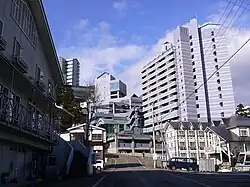 Ishiuchi Resort area | |
 Flag  Seal | |
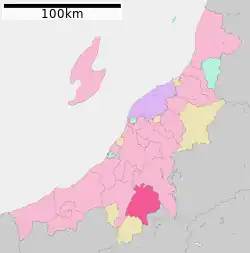 Location of Minamiuonuma in Niigata | |
 Minamiuonuma | |
| Coordinates: 37°3′55.9″N 138°52′33.9″E | |
| Country | Japan |
| Region | Chūbu (Kōshin'etsu) (Hokuriku) |
| Prefecture | Niigata |
| Area | |
| • Total | 584.55 km2 (225.70 sq mi) |
| Population (December 1, 2020) | |
| • Total | 55,354 |
| • Density | 95/km2 (250/sq mi) |
| Time zone | UTC+9 (Japan Standard Time) |
| Symbols | |
| • Tree | Kobushi magnolia |
| • Flower | Erythronium japonicum |
| Phone number | 0250-62-2510 |
| Address | 180-1 Muika-machi, Minamiuonuma-shi, Niigata-ken 949-6696 |
| Website | Official website |
Geography
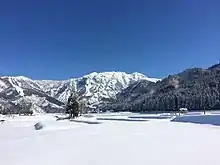
Minamiuonuma is situated in a valley in a mountainous region of Niigata Prefecture known as “Snow Country” because of the heavy snowfall in winter. The city is bounded by Uonuma and the Echigo-Sanzan mountains in the north, and Yuzawa, a popular ski resort town, in the south. The Uono River flows through most of the city. The city and its surrounding areas are dotted with many onsen (hot springs) and ski resorts, making it a popular destination in winter. There are also a large number of paddy fields, and popular seasonal fruit like watermelon, as this is part of the major koshihikari rice-growing region in Japan. Parts of the city are within the borders of the Jōshin'etsu-kōgen National Park.
Surrounding municipalities
Climate
Minamiuonuma has a Humid climate (Köppen Cfa) characterized by warm, wet summers and cold winters with heavy snowfall. The average annual temperature in Minamiuonuma is 11.3 °C. The average annual rainfall is 1865 mm with September as the wettest month. The temperatures are highest on average in August, at around 24.3 °C, and lowest in January, at around -1.1 °C.[2]
Demographics
Per Japanese census data,[3] the population of Minamiuonuma peaked around 1950 and has since declined to about the same level as a century ago.
| Year | Pop. | ±% |
|---|---|---|
| 1920 | 51,366 | — |
| 1930 | 56,414 | +9.8% |
| 1940 | 59,970 | +6.3% |
| 1950 | 72,360 | +20.7% |
| 1960 | 68,650 | −5.1% |
| 1970 | 61,995 | −9.7% |
| 1980 | 62,830 | +1.3% |
| 1990 | 65,566 | +4.4% |
| 2000 | 65,492 | −0.1% |
| 2010 | 61,624 | −5.9% |
| 2020 | 54,851 | −11.0% |
History
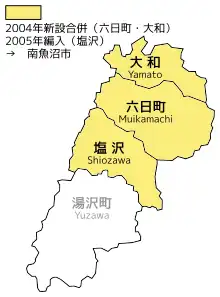
The area of present-day Minamiuonuma was part of ancient Echigo Province. The village of Muikamachi was created with the establishment of the modern municipalities system on April 1, 1889 and was raised to town status on July 13, 1900. The city of Minamiuonuma was established on November 1, 2004, from the merger of the towns Muikamachi with the neighboring town of Yamato (both from Minamiuonuma District). On October 1, 2005, the town of Shiozawa (from Minamiuonuma District) was also merged into Minamiuonuma.
Government

Minamiuonuma has a mayor-council form of government with a directly elected mayor and a unicameral city legislature of 22 members. Minamiuonuma, together with the town of Yuzawa, contributes two members to the Niigata Prefectural Assembly. In terms of national politics, the city is part of Niigata 5th district of the lower house of the Diet of Japan.
Economy
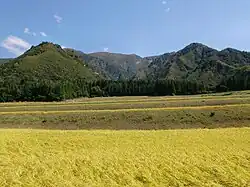
The economy of Minamiuonuma is based primarily on agriculture and seasonal tourism.
Education
Minamiuonuma has 17 public elementary schools and four public middle schools operated by the city government. There are four public high schools operated by the Niigata Prefectural Board of Education, and the prefecture also operate one special education school for the handicapped. The International University of Japan is based at Minamiuonuma.
Transportation
Railway
Highway
 Kan-etsu Expressway – Shiozawa-Ishiuchi IC, Muikamachi IC
Kan-etsu Expressway – Shiozawa-Ishiuchi IC, Muikamachi IC National Route 17
National Route 17 National Route 253
National Route 253 National Route 291
National Route 291 National Route 353
National Route 353
Twin towns – sister cities
Minamiuonuma is twinned with:[4]
 Ashburton, New Zealand (1987)
Ashburton, New Zealand (1987) Lillehammer, Norway (1992)
Lillehammer, Norway (1992) Sölden, Austria (1982)
Sölden, Austria (1982)
Local attractions
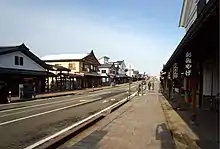
- Sakado Castle ruins, a National Historic Site
- Hakkaisan Ropeway, aerial lift that climbs Mount Hakkai
- Untoan Temple, Buddhist temple
- Shiozawajuku, old shopping street
References
- Minamiuonuma city official statistics (in Japanese)
- Minamiuonuma climate data
- Minamiuonuma population statistics
- "姉妹都市交流" (in Japanese). Minamiuonuma. Retrieved 2020-07-10.
External links
 Media related to Minamiuonuma, Niigata at Wikimedia Commons
Media related to Minamiuonuma, Niigata at Wikimedia Commons- Official Website (in Japanese)
